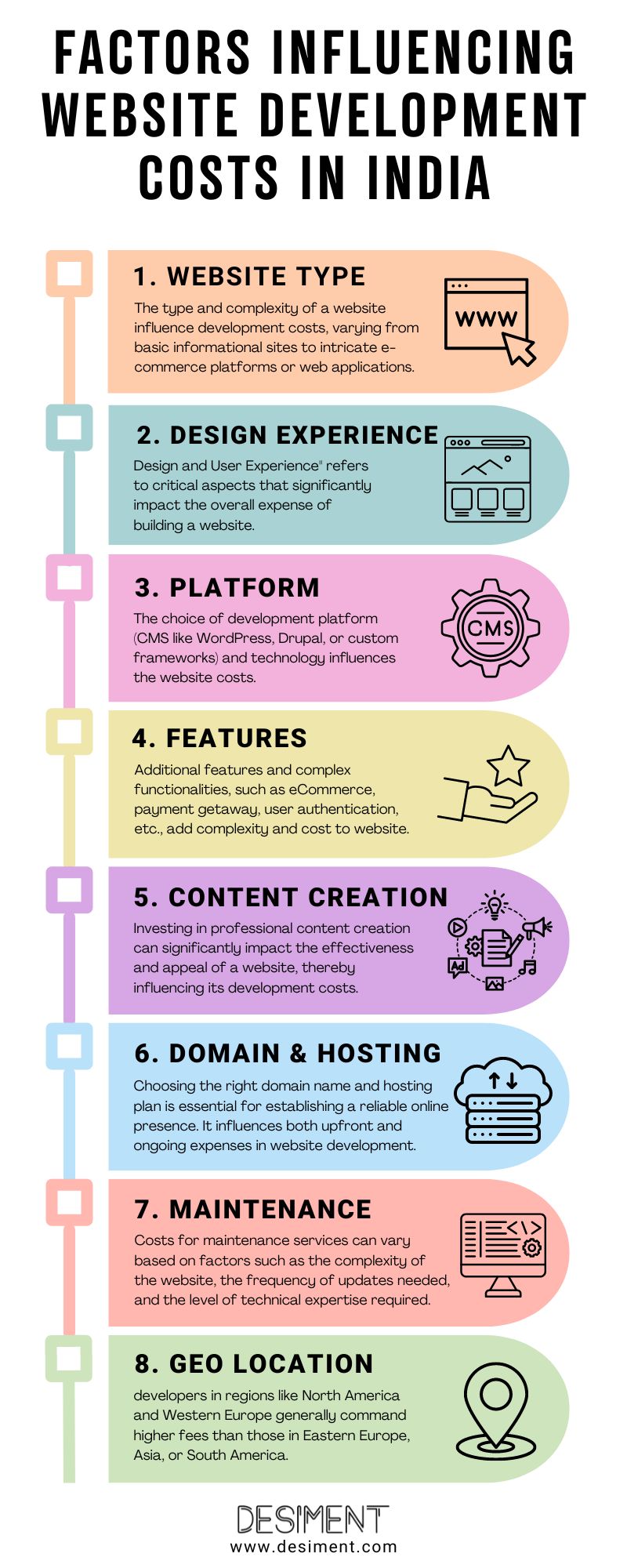In 2024, the average cost of website development in India will be relatively lower compared to many Western countries due to differences in labour costs and overheads.
However, prices can still vary significantly based on the complexity of the well-designed website, the expertise of the developer or agency, and specific requirements.
Analysis of Website Development Costs in India
Here’s a breakdown of the typical costs you might encounter for website development in India:
1. Domain Name: Generally, domain registration costs are similar worldwide, ranging from ₹700 to ₹3000 per year (~$10 – $40 USD), depending on the domain extension (.com, .in, .net, etc.).
2. Web Hosting: Hosting service costs can vary based on the type of hosting and the resources allocated. In India, you might find the following approximate costs:
- Shared Hosting: ₹200 to ₹1000 per month (~$3 – $15 USD)
- VPS Hosting: ₹1000 to ₹5000+ per month (~$15 – $70+ USD)
- Dedicated Hosting/Server: ₹5000 to ₹20,000+ per month (~$70 – $280+ USD)
3. SSL Certificate: Prices can range from free (Let’s Encrypt) to ₹2000 to ₹10,000+ per year (~$30 – $140+ USD) for premium SSL certificates.
4. Website Design and Development: Costs for design and development services in India can vary widely based on the complexity, features and types of websites required:
- Basic Website: ₹10,000 to ₹50,000+ (~$150 – $700+ USD)
- Custom Website: ₹50,000 to ₹2,00,000+ (~$700 – $2800+ USD)
- eCommerce Website / Online Platform Website: ₹50,000 to ₹5,00,000+ (~$700 – $7000+ USD), depending on the scale and functionalities required.
5. Content Management System (CMS): Popular CMS platforms like WordPress are generally free to use, but you might need to pay for themes (₹1500 to ₹10,000+ / ~$20 – $140+ USD) or plugins/extensions (₹1000 to ₹5000+ / ~$15 – $70+ USD).
6. E-commerce Functionality: Costs for setting up an online store can vary:
- Payment gateway setup: Free to ₹5000+ setup fee (~$70+ USD), plus transaction fees.
- Shopping cart integration: Free to ₹20,000+ (~$280+ USD), depending on complexity.
7. Maintenance cost and Updates: Depending on the level of support required, ongoing costs for maintenance and updates might range from ₹3000 to ₹15,000+ per month (~$40 – $210+ USD).
8. Additional Costs: Other potential costs may include:
- SEO optimization: ₹10,000 to ₹50,000+ (~$140 – $700+ USD)
- Content creation: ₹1000 to ₹10,000+ per hour (~$15 – $140+ USD) for copywriting or content creation
- Graphic design: ₹500 to ₹5000+ per hour (~$7 – $70+ USD) for custom graphics or branding
Estimated Cost Total of Website Designing
For a basic informational website in India, you might expect to spend anywhere from ₹20,000 to ₹1,00,000+ ($280 – $1400+ USD).
Depending on the scope and requirements, more complex websites with advanced features or e-commerce functionalities could cost anywhere from ₹1,00,000 to ₹10,00,000+ ($1400 – $14,000+ USD).
To get a precise estimate for your project, it’s advisable to obtain detailed quotes from developers or agencies based on your specific needs.
Additionally, factor in ongoing costs for hosting, domain renewals, and maintenance when planning your website budget.
Exploring Key Factors Affecting Website Development Costs in India

1. Type and Complexity of Website
The type and complexity of a website significantly impact development costs. Websites can range from simple informational sites to complex e-commerce platforms or web applications. Here’s a cost breakdown based on different types:
- Basic/Simple Website: This typically includes a few pages (Home, About Us, Contact) with minimal custom design and functionality. The cost ranges from ₹10,000 to ₹50,000 (~$140 – $700 USD).
- Corporate Website: Corporate websites are expansive, often spanning more than 30 pages to accommodate a wealth of information. These sites require sophisticated database management, robust hosting solutions, and intricate maintenance systems to ensure seamless operation. Costs range from ₹50,000 to ₹2,50,000 (~$700 – $3500 USD).
- E-commerce Website: Involves more extensive development, including product listings, shopping cart functionality, payment gateway integration, and possibly inventory management. Costs vary widely depending on the number of products and features, ranging from ₹50,000 to ₹5,00,000+ (~$700 – $7,000+ USD).
- Custom Web Applications: These are tailored solutions with specific functionalities such as user portals, databases, or complex integrations. Costs can start from ₹1,00,000 and go upwards based on project scope and requirements.
2. Design and User Experience (UX/UI)
The design and user experience elements of a website are crucial for attracting and retaining visitors. Costs for design services depend on:
- Custom vs. Template Design: Custom designs tailored to specific branding and user experience requirements generally cost more than using pre-designed templates.
- Responsive Design: Ensure the website is mobile-friendly, which adds to development costs but is essential for reaching a broader audience.
3. Development Platform and Technology Stack
The choice of development platform (CMS like WordPress, Drupal, or custom frameworks) and technology stack (programming languages, databases, frameworks) influences costs:
CMS-based Websites
Cost-effective solutions using platforms like WordPress or Joomla with extensive plugin ecosystems can reduce development time and costs.
- WordPress: A popular choice for its user-friendly interface, wide range of plugins, and scalability. Ideal for blogs, small to medium-sized websites, and some e-commerce applications.
- Joomla: Known for its flexibility and ability to handle more complex content structures. Suitable for websites that require robust content management capabilities.
- Drupal: Drupal offers advanced customization options and is preferred for large, enterprise-level websites or applications that require scalability and security.
Custom Development
Tailored solutions built from scratch using programming languages like PHP, Python, Ruby, or frameworks like Laravel, Django, or Ruby on Rails. Provides complete control over functionality and design but requires more development time and expertise.
4. Features and Advanced Functionalities
Additional features and complex functionalities add complexity and cost to website development:
- E-commerce Functionality: Integrating shopping carts, payment gateways (e.g., PayPal, Stripe), and order management systems incur additional costs.
- User Authentication and Profiles: Developing user login systems, profiles, and personalized content delivery mechanisms can increase development expenses.
- SEO and Analytics Integration: Incorporating search engine optimization (SEO) best practices and analytics tools (e.g., Google Analytics) into the website enhances visibility and user insights but adds to development costs.
- Social Media Integration: Allowing users to share content or products on social media platforms. Simplifying registration and login processes using social media credentials. Displaying social media feeds or integrating reviews and testimonials from social platforms.
- Mobile Responsiveness and Cross-Browser Compatibility: Ensuring the website adapts seamlessly to different screen sizes and devices (desktops, tablets, smartphones). Testing and optimizing the website to work consistently across major web browsers (Chrome, Firefox, Safari, Edge).
- Security Features: Implementing robust security measures in website development is crucial to protect against cyber threats and ensure data integrity. SSL certification encrypts data between users and servers, preventing interception. Firewalls and malware protection are essential for blocking unauthorized access and detecting malicious software.
- Additional Functionalities: Event booking and calendar integration enable seamless appointment scheduling and event management for users. Multilingual support facilitates reaching a diverse audience by offering content in multiple languages, improving accessibility and user experience. Integration with third-party services via APIs extends functionality, enabling seamless integration of services like shipping, CRM, and email marketing into the website. The cost of third-party integrations can range from ₹5,000 to ₹50,000.
5. Content Creation and Migration
The creation and migration of content (text, images, videos) to the new website can impact costs:
- Copywriting and Content Strategy: Professional copywriting services ensure clear and engaging content tailored to target audiences.
- Media Creation: High-quality images, videos, or graphic design elements may require additional investment.
6. Domain Name and Hosting
Basic infrastructure costs include:
- Domain Registration: Prices typically range from ₹700 to ₹3,000 per year (~$10 – $40 USD), depending on the domain extension (.com, .in, etc.).
- Web Hosting: Costs vary based on the type of hosting (shared, VPS, dedicated) and resources allocated (storage, bandwidth). Expect monthly fees ranging from ₹200 to ₹20,000+ (~$3 – $280+ USD).
- SSL Certificates: Essential for secure connections (HTTPS), SSL certificates cost from free (Let’s Encrypt) to ₹10,000+ (~$140+ USD) annually for premium certificates.
7. Maintenance and Support
Post-launch costs include:
- Ongoing Maintenance: Regular updates, security patches, and technical support services range from ₹3,000 to ₹15,000+ per month (~$40 – $210+ USD).
- Content Updates: Updating content, adding new features, or optimizing for SEO requires ongoing investment.
8. Geographic Location and Developer Expertise
Costs can vary based on the location and expertise of web development teams:
- Metro Cities vs. Tier-II/Tier-III Cities: Developers in metro cities like Bangalore, Mumbai, or Delhi may charge higher rates compared to developers in smaller cities or towns.
- Freelancers vs. Agencies: Freelancers generally have lower hourly rates compared to established web development agencies but may offer varying levels of expertise and support.
Conclusion
In conclusion, estimating website development costs in India for 2024 requires careful consideration of numerous factors.
By understanding the variables influencing costs—such as website type, design complexity, development platform, and ongoing maintenance—businesses and individuals can make informed decisions about budget allocation and project scope.
Whether launching a simple informational site or a complex e-commerce platform, investing in professional website development ensures a robust online presence aligned with business goals.





